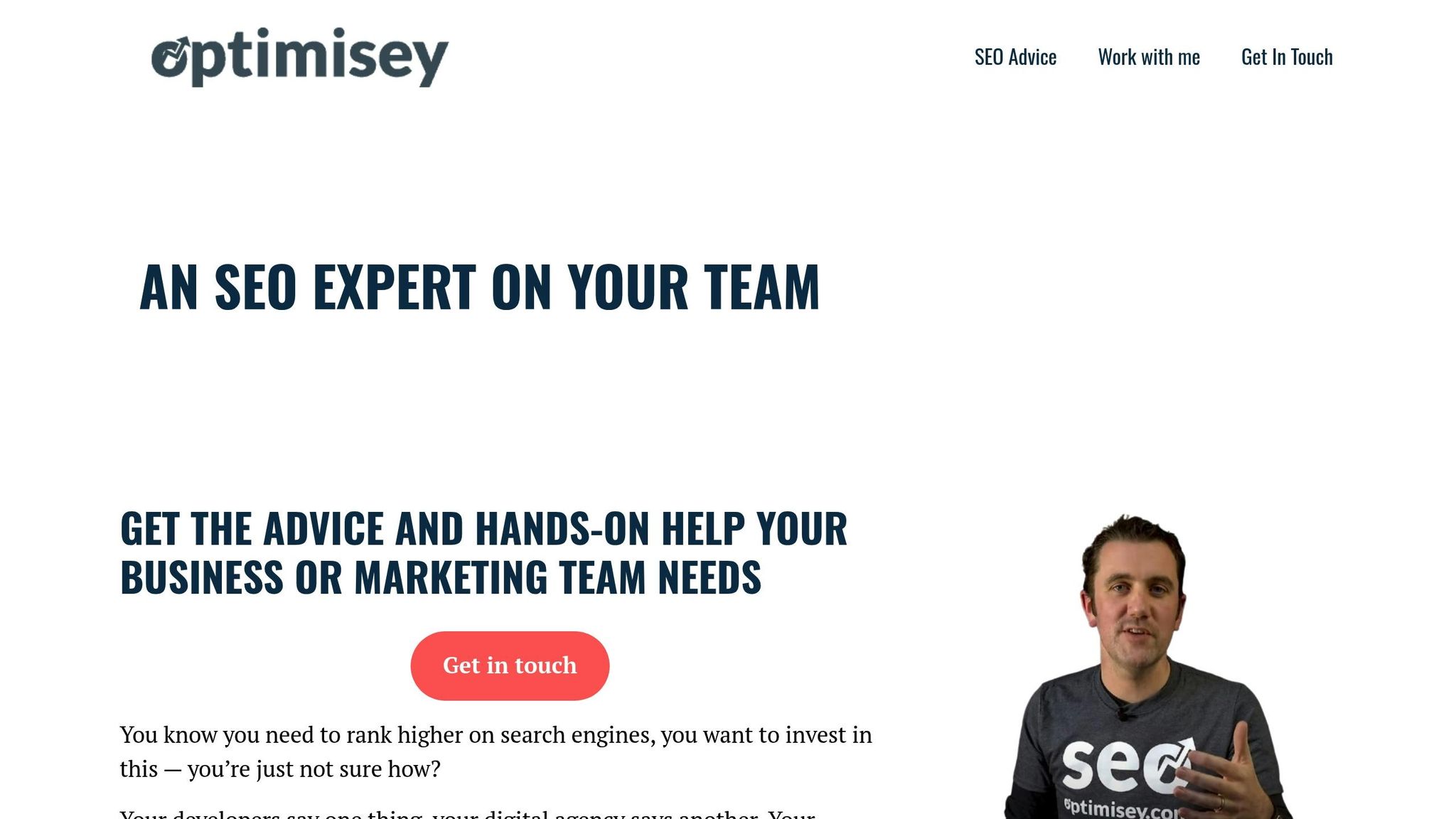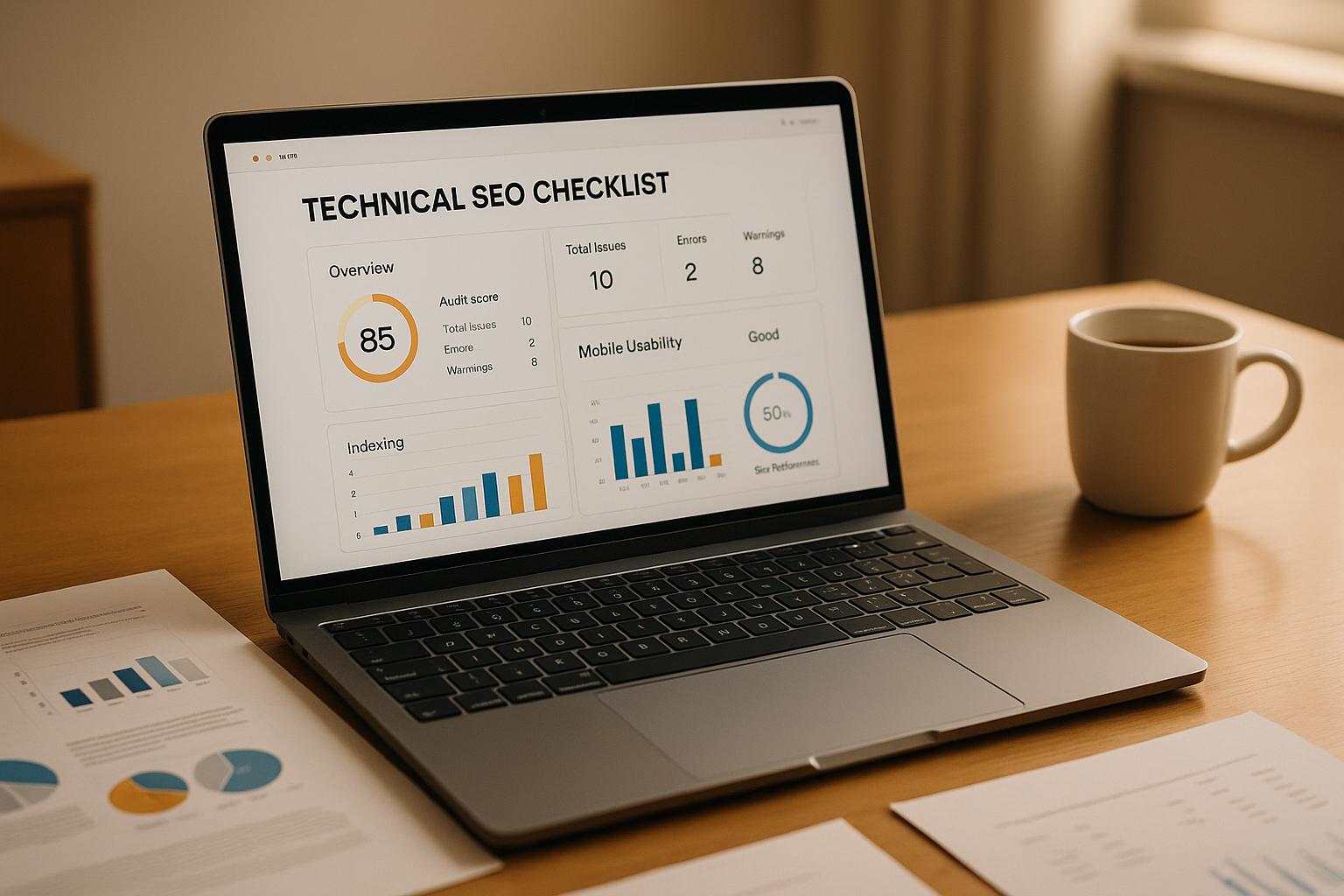Want to beat your competitors in search rankings? Start with technical SEO. In 2025, technical SEO is the backbone of high-performing websites, directly impacting rankings, user experience, and conversions. By analyzing your competitors, you can identify what works, where they fall short, and how to improve your own site. Here’s the quick breakdown:
- Focus Areas: Site speed, mobile optimization, crawlability, site structure, and security.
- Why It Matters: Faster sites rank higher and convert better. Mobile-first indexing and Core Web Vitals are non-negotiable.
- How to Start: Identify competitors outranking you for key terms. Analyze their technical setup – loading speeds, navigation, sitemaps, and HTTPS protocols.
- Tools to Use: PageSpeed Insights, mobile testing tools, and crawl analyzers.
- Action Plan: Prioritize fixes with the most impact, like improving load times or fixing crawl errors. Regularly monitor competitors to stay ahead.
Get the details below to fine-tune your SEO strategy and outperform others in 2025.
Technical SEO Competitive Analysis – Niki Mosier at Optimisey

Finding and Researching Your Competitors
Before diving into analyzing your competitors’ technical SEO strategies, you first need to identify who they are. It’s important to remember that your SEO competitors aren’t always the same as your business competitors – they’re the websites consistently outranking you for the keywords you’re targeting. Let’s explore how to pinpoint these competitors effectively.
How to Find Your Real Competitors
Start by examining search results for your primary keywords. Use incognito mode and search for 10–15 of your most important keywords. Take note of the websites that consistently appear in the top 10 search results.
As you analyze, you’ll notice different types of competitors:
- Direct competitors: Businesses offering similar products or services to the same audience.
- Indirect competitors: Websites targeting your keywords for other purposes, like blogs, news outlets, or educational sites.
- SERP competitors: Sites that regularly appear alongside yours in search results, even if they’re in unrelated industries.
Expand your keyword list using Google’s search suggestions. As you type in your main keywords, Google will display related search terms that actual users are looking for. Check who ranks for these variations – you might uncover competitors you didn’t initially consider.
If your business serves specific regions, geographic location is crucial. Repeat this process with location-specific searches to identify competitors in each market you serve.
Additionally, look beyond the first page of search results to find sites with a solid technical foundation. These sites might not have the best content yet, but they could become serious competitors if they improve their content strategy.
Once you’ve identified your competitors, gather the data you need to create detailed profiles for each one.
Creating a Competitor Profile
Building a competitor profile gives you the foundation for analyzing their technical SEO strategies. Here’s what to focus on:
- Website size and structure: This provides insights into their content strategy and technical setup. Note their main navigation categories, estimate the number of pages, and check for subdomains or subdirectories. A website with 50,000 pages faces very different challenges than one with 500 pages.
- Traffic patterns: While exact traffic numbers aren’t publicly available, you can gauge their reach by observing their social media activity, how often they update content, and how frequently they appear in search results for various keywords.
- Target audience overlap: Look at their content themes, tone, and the problems they address. A competitor targeting the same audience with similar solutions is a bigger threat than one operating in a different niche.
- Technical infrastructure: Even a quick look can reveal a lot. Check if they use HTTPS, how their URLs are structured, and whether their site loads quickly. Look for signs of advanced technical optimization, like mobile apps or content delivery networks.
- Content and keyword focus: Browse their website to see which keywords they’re targeting. Pay attention to page titles, headings, and URL structures to understand their SEO approach.
To keep track of this information, create a simple spreadsheet. Include columns for the competitor’s URL, estimated site size, main keyword themes, target audience, and initial technical observations. This document will serve as your go-to resource for deeper technical analysis later.
The goal here isn’t to mimic your competitors but to understand the competitive landscape. By identifying gaps in their strategies and areas where you can excel, you’ll be better positioned to outperform them. These profiles lay the groundwork for a more detailed technical analysis in the next steps.
Main Technical SEO Elements to Check
Once you’ve mapped out your competitors and built detailed profiles, it’s time to dig into the technical factors that influence their rankings. These five areas will give you insight into how well your competitors have optimized their websites for both search engines and users.
Site Speed and Core Web Vitals
Google uses three key metrics to measure page performance. Here’s what to focus on:
- Largest Contentful Paint (LCP): This measures how fast the main content on a page loads. Ideally, LCP should be 2.5 seconds or faster. Use tools like PageSpeed Insights to analyze your competitors’ LCP scores on their homepage and key landing pages, and see how they stack up against Google’s benchmarks.
- First Input Delay (FID): This tracks how quickly a page responds to user actions, like clicking a button. Pages should respond in under 100 milliseconds. Since FID requires real user data, you can use Interaction to Next Paint (INP) as an alternative metric to gauge responsiveness.
- Cumulative Layout Shift (CLS): This measures how stable a page’s content is during loading. A good CLS score is below 0.1. Poor scores often result from things like images or ads shifting around due to undefined dimensions.
Beyond these, check Time to First Byte (TTFB), which measures how quickly a server responds. A fast server typically responds within 200-500 milliseconds. If competitors show consistently slow TTFB scores, it could indicate poor hosting or server-side issues – an opportunity for you to do better.
Be thorough: analyze multiple pages for each competitor, not just their homepage. For example, e-commerce sites might have fast-loading homepages but sluggish product pages, while blogs might optimize articles but neglect category pages. These details can reveal where you can gain an edge.
Mobile Optimization
With mobile traffic dominating the web, optimizing for mobile isn’t optional – it’s essential. Start by testing your competitors’ websites on mobile devices or use browser developer tools to simulate mobile views.
- Responsive design is key. Check if competitors’ sites adjust seamlessly to different screen sizes and maintain fast loading speeds on mobile. Watch for issues like horizontal scrolling or text that’s too small to read comfortably.
- Touch-friendly elements matter. Buttons, links, and other interactive features should be at least 44 pixels wide and tall to make them easy to tap. If competitors have tiny buttons or links, they’re creating frustrating user experiences.
- Mobile navigation should be simple and intuitive. Look for features like hamburger menus or sticky navigation bars. These make it easier for users to explore a site on smaller screens.
- Font readability is critical. Text should be at least 16 pixels in size so users don’t need to pinch and zoom to read content. Competitors who overlook this are leaving room for you to create a better experience.
Use the mobile testing feature in PageSpeed Insights to gather performance data specific to mobile pages. Once you’ve assessed mobile performance, move on to crawlability and indexation.
Crawlability and Indexation
For search engines to rank a page, they first need to crawl and index it. Examining how well competitors manage this process can uncover hidden opportunities.
- Check robots.txt files by visiting
domain.com/robots.txt. This file tells search engines which parts of a site to crawl or ignore. Look forDisallowdirectives that might block important pages like product listings or blog posts. - Look for XML sitemaps at
domain.com/sitemap.xmlor in the robots.txt file. Well-organized competitors often have separate sitemaps for pages, images, and other content types, helping search engines navigate their site more effectively. - On larger sites, managing crawl budget is crucial. Competitors with thousands of pages need to ensure search engines prioritize crawling high-value content. Look for signs of wasted crawl budget, like duplicate pages or broken internal links.
- Canonical tags help prevent duplicate content issues. Check competitors’ page code for
<link rel="canonical">tags. Missing or incorrect tags can dilute their ranking power across similar pages. - Analyze internal linking structures to see how competitors help search engines find and rank key pages. Strong internal linking often involves linking to important content from navigation menus, footers, or within articles. This can give you ideas on how to improve your own strategy.
Site Structure and Navigation
A well-organized site is easier for both users and search engines to navigate. When reviewing competitors, focus on how they structure and present their content.
- URL structure should be clean and descriptive. For example,
/products/running-shoes/nike-air-maxis better than/product.php?id=12345&cat=shoes. Clean URLs often signal a better technical SEO setup. - Navigation hierarchy should flow logically, starting with broad categories and narrowing down to specific pages. If it takes too many clicks to reach key content, competitors may be hurting their user experience and rankings.
- Breadcrumb navigation is a helpful feature that shows users where they are within a site. Competitors using breadcrumbs on category and product pages often demonstrate better attention to technical SEO.
- Internal link distribution plays a role in how authority flows through a site. Check which pages competitors link to most often from their menus or within content. This can reveal which pages they prioritize for rankings.
- Test site search functionality to see how well competitors help users find specific content. Poor search features can indicate broader content organization issues.
Security and Protocols
Security is more than just a user trust factor – it’s a confirmed ranking signal. A competitor’s security setup can reveal their technical sophistication.
- HTTPS implementation is now the standard. Look for the padlock icon in the browser address bar to confirm competitors use secure connections. Sites still using HTTP are at a disadvantage.
- Check SSL certificate validity using browser tools. Look for expiration dates and ensure certificates cover all subdomains competitors use. Misconfigured or expired certificates can cause crawling issues.
- Security headers like Content Security Policy (CSP) or Strict-Transport-Security add extra layers of protection. Use browser developer tools or online checkers to see if competitors have these in place.
- Watch for mixed content issues, where HTTPS pages load some resources (like images or scripts) over HTTP. These can hurt user experience and cause loading problems. Browser warnings can help you spot these issues.
- Finally, look for redirect chains and loops by testing different URL versions (e.g., with/without "www", HTTP vs. HTTPS). Long redirect chains or loops can slow down pages and waste crawl budget, giving you another opportunity to outperform competitors.
Comparing Competitor Technical SEO Results
Once you’ve gathered all the technical data, the next step is to compare these metrics across your competitors. A structured comparison not only highlights where competitors are excelling but also pinpoints areas where they fall short. This gives you a clear roadmap for improving your own technical SEO.
Building a Competitor Comparison Table
A comparison table is an efficient way to organize and analyze the data you’ve collected. Start by listing three to five of your top competitors in the leftmost column. Then, create additional columns for each technical factor you’ve assessed.
For instance, include specific Core Web Vitals scores, such as LCP (Largest Contentful Paint) times (e.g., Competitor A: 1.8s; Competitor B: 3.2s). This makes it easy to see which sites offer a better user experience. Be sure to include both desktop and mobile scores, as performance can vary significantly across devices.
You can also add a column to rate subjective elements, like navigation usability, using labels such as "Excellent", "Good", "Fair", or "Poor." This provides clarity, especially for factors that aren’t purely numerical.
Incorporate HTTPS status, SSL validity, and any mixed content issues. For example, if a competitor is still using HTTP in 2025, this presents a clear opportunity for you to gain an edge.
Don’t forget crawlability metrics, such as the presence of XML sitemaps, robots.txt configurations, and the strength of internal linking. For example, internal linking can be rated as "strong" if the site has a logical structure and clear hierarchies, or "weak" if the navigation is disorganized.
Finally, assess the site structure, including URL cleanliness, breadcrumb usage, and navigation depth. While each of these factors may seem minor on its own, collectively, they can significantly impact user experience and search engine crawling efficiency. This structured approach helps you identify actionable opportunities.
Finding Strengths and Weaknesses
Once your comparison table is complete, take a step back and analyze it for patterns and opportunities. Look for competitors who perform well across the board – they represent both strong competition and benchmarks for your efforts.
Identify common weaknesses, such as slow mobile loading speeds. For example, if three out of five competitors have mobile load times exceeding 4 seconds, focusing on mobile optimization could give you a noticeable edge. These widespread weaknesses often represent the best opportunities for quick wins.
Pay attention to inconsistencies. A competitor might excel in Core Web Vitals but have poor mobile navigation, or they might have strong security protocols but messy URL structures. These gaps can reveal their priorities – and their blind spots.
You can also spot trends in resource allocation. Larger companies often perform well in basic areas like HTTPS implementation and mobile responsiveness but may struggle with advanced optimizations, such as crawl budget management on their large sites. On the other hand, smaller competitors might have fast-loading pages but lack comprehensive XML sitemaps or proper canonical tags.
Look for a connection between technical performance and market position. If the market leader has mediocre technical SEO scores, it suggests you could compete more effectively by focusing on technical improvements. On the flip side, if top competitors all have excellent technical performance, matching their standards becomes essential to stay in the game.
Also, keep an eye on recent changes. For example, if a competitor’s Core Web Vitals have suddenly improved, it likely means they’ve invested in upgrades. This could signal that they’re prioritizing SEO, giving you insight into their strategies and future plans.
Lastly, your comparison will often reveal quick wins. If competitors are missing basic optimizations – like proper canonical tags or clean URL structures – these should be immediate priorities for your technical SEO plan. These foundational fixes tend to deliver results faster than more complex strategies.
Next Steps for Your Technical SEO Plan
Take what you’ve learned from analyzing competitors and turn those insights into actionable steps. The goal? Build a targeted plan that tackles the most pressing issues first.
Ranking Fixes by Business Impact
Not all technical SEO issues are created equal. Some have a greater impact on your visibility and conversions than others. To stay efficient, group your findings into three priority levels based on their potential effect.
High-priority fixes should address problems that directly influence user experience and search engine crawling. For example, if your Core Web Vitals are lagging – say competitors have an LCP (Largest Contentful Paint) score under 2.5 seconds while yours is over 4 seconds – this can hurt your rankings and conversions. Similarly, outdated security protocols like using HTTP instead of HTTPS could push search engines to favor competitors. Mixed content issues, where HTTPS pages load HTTP resources, can also scare off users with browser warnings.
Medium-priority fixes focus on structural improvements that enhance crawlability and navigation. This might include cleaning up your XML sitemap, improving internal linking, or organizing URL parameters. For instance, if competitors have a cleaner site architecture with intuitive breadcrumb navigation while yours feels messy, addressing this can improve both user experience and how search engines interpret your content.
Low-priority fixes involve smaller technical tweaks that provide incremental benefits. These could include optimizing your robots.txt file, adding structured data markup, or refining canonical tags. While these changes are important for a well-rounded SEO strategy, they usually don’t deliver immediate traffic boosts.
When deciding what to tackle first, weigh the required resources against the potential impact. A low-impact fix that takes 30 minutes might deliver better ROI than a high-impact fix requiring weeks of development. Timing matters too – if you’re in retail, improving site speed before Black Friday is far more urgent than waiting until after the holiday season. Similarly, if competitors consistently outperform you during peak times, closing those technical gaps becomes a priority.
Once you’ve outlined your priorities, the next step is to choose the right tools and expertise to implement these changes.
Using Tools and Services
Your competitor analysis can guide you in selecting the best tools and services to address technical SEO issues efficiently. The right approach will depend on your team’s technical know-how, budget, and the complexity of the problems you’re tackling.
For businesses with limited in-house technical resources, professional technical SEO services can handle everything from audits to implementation. These services are particularly helpful for addressing complex issues like server configurations, crawl budget optimization, and large-scale site architecture improvements. For example, SearchX provides in-depth site audits and can manage everything from HTTPS migrations to advanced optimizations, ensuring all updates align with current search engine standards.
If you prefer a hands-on approach, DIY local SEO resources can guide smaller businesses or teams with some technical skills through many of these improvements. This is a great option for simpler sites or for those looking to tackle straightforward fixes internally.
For businesses managing multiple locations or franchises, specialized local SEO services become essential. These address unique challenges like maintaining consistent NAP (Name, Address, Phone) data across platforms, optimizing for location-specific search algorithms, and implementing schema markup tailored to each location.
A hybrid approach can often be the most effective. Use professional services for complex or foundational changes, then rely on your internal team for routine maintenance and monitoring. For many businesses, this balance ensures both quality and cost-efficiency.
Finally, align your budget with competitor benchmarks. If competitors are heavily investing in technical SEO, you’ll need to match their efforts just to keep pace. On the other hand, if your analysis shows that competitors have weak technical foundations, investing strategically in improvements could give you a major edge.
Track your ROI by monitoring metrics like organic traffic, conversion rates, and search visibility. These indicators will help you justify continued investment and refine your priorities over time.
Technical SEO isn’t a one-and-done task. Search engines update their algorithms, web technologies evolve, and user expectations grow. While your competitor analysis provides a snapshot of the current landscape, staying ahead means committing to ongoing monitoring and updates.
Set up regular review cycles – quarterly for most businesses, or monthly for highly competitive industries. These reviews will help you stay on top of changes and keep your technical SEO efforts sharp and competitive.
Conclusion: Staying Ahead with Technical SEO in 2025
Using insights from competitor analysis, staying ahead in 2025 means more than just fine-tuning technical elements – it’s about creating a solid foundation that keeps your business competitive in search rankings. The digital landscape evolves rapidly, so what worked last year may no longer be effective.
Key Takeaways from the Checklist
Successful businesses treat these benchmarks as a guide to outpace their competitors. Data-driven analysis beats guesswork every time. Interestingly, your fiercest SEO competition might not come from your usual business rivals. For example, a small bakery could outrank a large restaurant chain simply because their technical SEO is better aligned with search engine preferences. In 2025, the winners will be those who focus on precision – tracking site speed in milliseconds and addressing crawl errors with methodical accuracy.
Action trumps perfection. Spending months on an exhaustive audit won’t help if you’re slow to act. High-impact changes, like shaving a couple of seconds off your page load time, can yield better results than obsessing over minor schema markup details. The businesses that thrive are those that treat technical SEO as an ongoing strategy rather than a one-off project. Search engines change, user expectations evolve, and new technologies emerge – constant monitoring is the only way to stay ahead.
The Need for Continuous Improvement
Technical SEO in 2025 demands a commitment to ongoing refinement. The businesses leading search rankings months from now will be the ones that consistently review their performance and adapt. Regular competitor analysis and swift implementation of fixes will be essential to maintaining an edge.
Monthly reviews are crucial for competitive industries. If you’re in e-commerce, SaaS, or local services, monitoring your competitors’ technical updates monthly can make a big difference. Algorithm changes, shifts in Core Web Vitals, and advancements in mobile optimization can dramatically alter rankings in a short time.
Seasonal trends provide opportunities for growth. Retailers optimizing for Black Friday in October often outperform those who wait until November. Similarly, travel companies that enhance mobile speed before the summer booking rush tend to see higher conversion rates. Competitors often follow seasonal patterns – spotting these early can give you a significant advantage.
Adapting to emerging technologies is non-negotiable. AI-driven search, voice queries, and changes in mobile device technology introduce new challenges every year. Businesses that quickly adapt – by using structured data for AI snippets or optimizing for new screen sizes – can achieve noticeable ranking boosts before competitors catch up.
The real value of technical SEO analysis lies not just in identifying what competitors are doing well, but in uncovering what they’re missing. These gaps represent your chance to gain ground with superior technical execution.
Set up systems to monitor competitor changes, track your progress against their benchmarks, and avoid complacency with your current setup. By continuously refining your technical SEO strategy, you’ll position your business for long-term success in an ever-changing digital landscape.
FAQs
How can I find my true SEO competitors if they differ from my business competitors?
When figuring out who your real SEO competitors are, don’t just think about businesses that offer the same products or services as you. Instead, focus on websites that rank for the keywords you’re targeting. These are the sites fighting for the same visibility on search engine results pages.
To pinpoint these competitors, use tools to dig into keyword rankings, analyze backlink profiles, and study their content strategies. This way, you’ll know exactly who’s vying for your audience’s attention, allowing you to fine-tune your SEO efforts and boost your organic search performance.
What technical SEO factors should I focus on in 2025 to boost my website’s search rankings?
To boost your website’s search rankings in 2025, it’s essential to focus on key technical SEO elements that can make a real difference:
- Site speed: A fast-loading site isn’t just good for users – it’s what search engines expect. Prioritize optimizing load times to keep visitors engaged and improve rankings.
- Mobile optimization: Your site should look and function perfectly on any device. A fully responsive, mobile-friendly design is non-negotiable.
- Crawlability: Help search engines navigate your site with ease. Use tools like structured data, XML sitemaps, and a well-configured robots.txt file to ensure efficient indexing.
- HTTPS security: Secure your site with HTTPS to protect user data and align with search engine requirements. It’s a trust signal that also impacts rankings.
- Clean site architecture: A clear, intuitive structure with easy navigation improves both user experience and crawl efficiency, making it easier for search engines to understand your content.
On top of these, don’t overlook problems like duplicate content or broken links. Fixing these ensures a smooth experience for users and keeps search engines happy. Staying on top of these technical aspects will help you remain competitive in the ever-changing world of SEO.
How can analyzing competitors help improve my technical SEO strategy?
Analyzing your competitors’ technical SEO can shed light on crucial factors like site speed, crawlability, and mobile optimization. By pinpointing their strengths and weaknesses, you can identify areas where your website can improve and stand out.
This approach not only helps you implement tried-and-tested strategies but also highlights key technical fixes that could be limiting your site’s potential. In the end, competitor analysis equips you with the insights needed to refine your strategy, improve search rankings, and maintain an edge in your industry.




